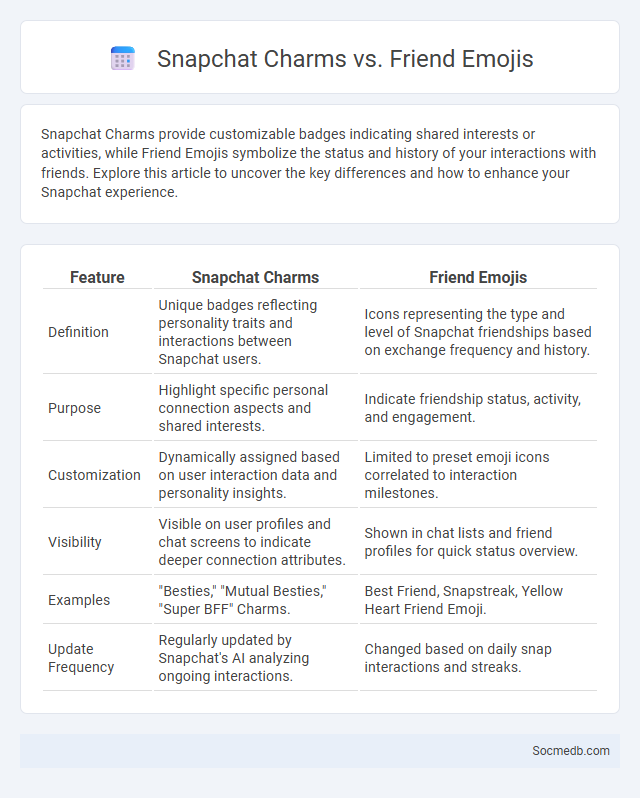
Photo illustration: Snapchat Charms vs Friend Emojis
Snapchat Charms provide customizable badges indicating shared interests or activities, while Friend Emojis symbolize the status and history of your interactions with friends. Explore this article to uncover the key differences and how to enhance your Snapchat experience.
Table of Comparison
| Feature | Snapchat Charms | Friend Emojis |
|---|---|---|
| Definition | Unique badges reflecting personality traits and interactions between Snapchat users. | Icons representing the type and level of Snapchat friendships based on exchange frequency and history. |
| Purpose | Highlight specific personal connection aspects and shared interests. | Indicate friendship status, activity, and engagement. |
| Customization | Dynamically assigned based on user interaction data and personality insights. | Limited to preset emoji icons correlated to interaction milestones. |
| Visibility | Visible on user profiles and chat screens to indicate deeper connection attributes. | Shown in chat lists and friend profiles for quick status overview. |
| Examples | "Besties," "Mutual Besties," "Super BFF" Charms. | Best Friend, Snapstreak, Yellow Heart Friend Emoji. |
| Update Frequency | Regularly updated by Snapchat's AI analyzing ongoing interactions. | Changed based on daily snap interactions and streaks. |
Understanding Snapchat Charms
Snapchat Charms allow users to track and celebrate relationship milestones by displaying icons representing interactions, such as Snap Streaks, Chat Frequency, and Shared Tags. These personalized symbols evolve based on engagement patterns, helping users analyze their social connections in unique, visual ways. Understanding Snapchat Charms enhances social media experience by offering insights into friendship dynamics and user activity within the app.
What Are Snapchat Friend Emojis?
Snapchat friend emojis are small icons that appear next to friends' names on Snapchat, symbolizing different aspects of your interaction and relationship on the app. These emojis change based on factors such as the frequency of snaps exchanged, mutual best friends, and streaks maintained between users. Understanding Snapchat friend emojis helps users track their social connections and engagement levels within the platform.
Key Differences Between Charms and Friend Emojis
Social media platforms utilize charms and friend emojis to enhance user interactions, yet these icons serve distinct purposes. Charms typically represent magical or special effects associated with content, highlighting unique or celebratory moments, whereas friend emojis symbolize specific relationship statuses or emotional connections between users, such as closeness or friendship levels. Understanding these differences improves clarity in digital communication and enhances personalized user engagement across networks like Instagram, Facebook, and Snapchat.
How Snapchat Charms Work
Snapchat Charms are special badges that highlight your unique connections with friends, appearing within chat profiles and group chats. These Charms update automatically based on your interactions, shared activities, and mutual interests, offering personalized insights into your social dynamics. By using Snapchat Charms, you can discover new ways to engage and strengthen Your friendships on the platform.
Personalizing Your Snapchat Friend Emojis
Personalizing your Snapchat friend emojis enhances your social media experience by reflecting unique interactions with your contacts. Adjusting these emojis based on your communication frequency, shared memories, and specific behaviors allows for a more meaningful and customized visual representation of relationships. You can strengthen your connections by tailoring these emoji choices to fit your individual friendship dynamics on Snapchat.
Pros and Cons of Snapchat Charms
Snapchat Charms enhance user engagement by highlighting relationships through customizable emojis and interactive features, fostering closer connections and personalized experiences. However, the system can create social pressure and feelings of exclusion when users misinterpret Charm rankings or experience diminished interactions. Privacy concerns also arise as Charm data reveals patterns about friendships that users may prefer to keep more discreet.
Meaning Behind Popular Friend Emojis
Friend emojis on social media convey nuanced meanings that go beyond simple expressions of friendship, reflecting different levels of intimacy and personality traits. The smiling face with hearts emoji often signifies deep affection and genuine care, while the face with sunglasses suggests a cool, laid-back vibe in your friendship. Understanding these subtle emoji meanings can enhance your online communication and help you connect more authentically with your social circle.
Customizing Your Snapchat Experience
Customizing your Snapchat experience enhances user engagement by tailoring filters, lenses, and story preferences to match personal interests. Utilizing Snapchat's settings allows you to control who views your content and manages notifications for a more streamlined interaction. Personalization boosts privacy and enjoyment, making your social media usage more meaningful and secure.
How to Unlock New Charms and Emojis
Discover new charms and emojis on social media by exploring platform updates and emoji keyboards regularly. Customize your messages with unique stickers, GIFs, and animated emojis to enhance Your interactions and express emotions more vividly. Utilize third-party apps or social media feature releases to unlock exclusive or seasonal charms and keep your conversations engaging and fresh.
Which Is Better: Charms or Friend Emojis?
Choosing between charms and friend emojis depends on your social media goals and personal expression style. Charms often add a unique, decorative touch that can make your posts stand out, while friend emojis enhance emotional connection and engagement with your audience. To maximize your social media impact, consider how you want to communicate your message and which element aligns best with Your brand and interaction preferences.
 socmedb.com
socmedb.com